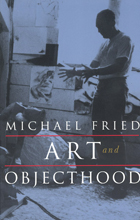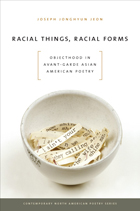2 books about Objecthood

Art and Objecthood
Essays and Reviews
Michael Fried
University of Chicago Press, 1998
Much acclaimed and highly controversial, Michael Fried's art criticism defines the contours of late modernism in the visual arts. This volume contains twenty-seven pieces, including the influential introduction to the catalog for Three American Painters, the text of his book Morris Louis, and the renowned "Art and Objecthood." Originally published between 1962 and 1977, they continue to generate debate today. These are uncompromising, exciting, and impassioned writings, aware of their transformative power during a time of intense controversy about the nature of modernism and the aims and essence of advanced painting and sculpture.
Ranging from brief reviews to extended essays, and including major critiques of Jackson Pollock, Morris Louis, Kenneth Noland, Jules Olitski, Frank Stella, and Anthony Caro, these writings establish a set of basic terms for understanding key issues in high modernism: the viability of Clement Greenberg’s account of the infralogic of modernism, the status of figuration after Pollock, the centrality of the problem of shape, the nature of pictorial and sculptural abstraction, and the relationship between work and beholder. In a number of essays Fried contrasts the modernist enterprise with minimalist or literalist art, and, taking a position that remains provocative to this day, he argues that minimalism is essentially a genre of theater, hence artistically self-defeating.
For this volume Fried has also provided an extensive introductory essay in which he discusses how he became an art critic, clarifies his intentions in his art criticism, and draws crucial distinctions between his art criticism and the art history he went on to write. The result is a book that is simply indispensable for anyone concerned with modernist painting and sculpture and the task of art criticism in our time.
Ranging from brief reviews to extended essays, and including major critiques of Jackson Pollock, Morris Louis, Kenneth Noland, Jules Olitski, Frank Stella, and Anthony Caro, these writings establish a set of basic terms for understanding key issues in high modernism: the viability of Clement Greenberg’s account of the infralogic of modernism, the status of figuration after Pollock, the centrality of the problem of shape, the nature of pictorial and sculptural abstraction, and the relationship between work and beholder. In a number of essays Fried contrasts the modernist enterprise with minimalist or literalist art, and, taking a position that remains provocative to this day, he argues that minimalism is essentially a genre of theater, hence artistically self-defeating.
For this volume Fried has also provided an extensive introductory essay in which he discusses how he became an art critic, clarifies his intentions in his art criticism, and draws crucial distinctions between his art criticism and the art history he went on to write. The result is a book that is simply indispensable for anyone concerned with modernist painting and sculpture and the task of art criticism in our time.
[more]

Racial Things, Racial Forms
Objecthood in Avant-Garde Asian American Poetry
Joseph Jonghyun Jeon
University of Iowa Press, 2012
In Racial Things, Racial Forms, Joseph Jonghyun Jeon focuses on a coterie of underexamined contemporary Asian American poets—Theresa Hak Kyung Cha, Myung Mi Kim, Mei-mei Berssenbrugge, and John Yau—who reject many of the characteristics of traditional minority writing, in particular the language of identity politics, which tends to challenge political marginalization without contesting more fundamental assumptions about the construction of racial form. In the poets’ various treatments of things (that is, objects of art), one witnesses a confluence of heretofore discrete factors: the avant-garde interest in objecthood and the racial question of objectification.
By refashioning avant-garde investigations of things into questions about how American discourse visualizes race in and on the body, these poets implicitly critique dominant modes of racial visibility, seeking alternatives to the unreflective stances that identity politics often unwittingly reproduces. At the heart of Jeon’s project is the assumption thatracial form is continually recalibrated to elide ideological ambiguities and ambivalences in contemporary culture. Thus, rather than focusing exclusively on the subject—on interiority and individual experience—Racial Things, Racial Forms also uses the calculated strangeness of the avant-garde art object as an occasion to emphasize the physical and visual oddness of racial constructs, as a series of everchanging, contemporary phenomena that are in conversation with, but not entirely determined by, their historical legacy.
In this critical study, Jeon argues that by invoking the foreignness of an avant-garde art object as a way to understand racial otherness, these writers model the possibility of a post-identity, racial politics that challenges how race is fundamentally visualized. In addition to appealing to those interested in Asian American studies and race in American literature, Racial Things, Racial Forms addresses readers interested in contemporary poetry, art, and visual culture, paying particular attention to the intersections between literary and visual art.
[more]
READERS
Browse our collection.
PUBLISHERS
See BiblioVault's publisher services.
STUDENT SERVICES
Files for college accessibility offices.
UChicago Accessibility Resources
home | accessibility | search | about | contact us
BiblioVault ® 2001 - 2024
The University of Chicago Press









